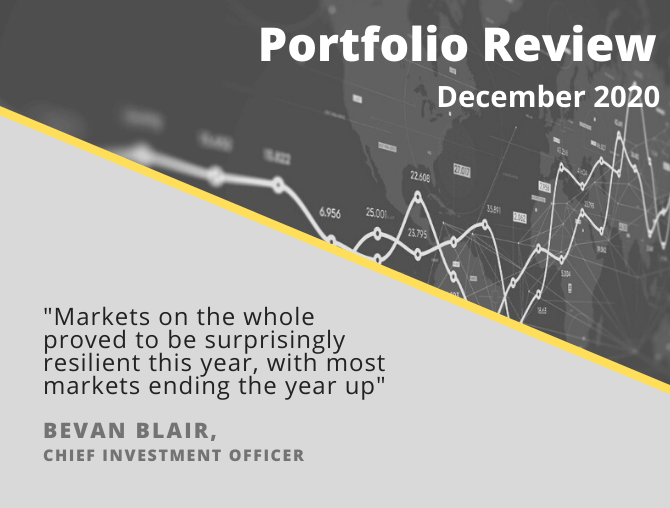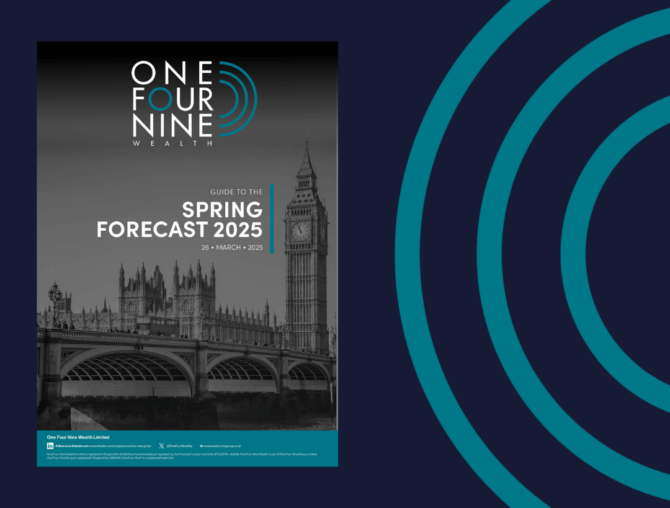
Portfolio Review – December 2020 – Issue 09
This is the latest One Four Nine Portfolio Management (OFNPM) portfolio review providing investors and advisers with an easy to digest overview of what’s happening in the markets globally, alongside comparisons of OFNPM’s portfolio performance each quarter and throughout the year.
Chief Investment Officer’s comments
Well, I guess we are all glad that 2020 is behind us, except we greet 2021 with more of the same with rising virus cases, lockdowns, and stuttering economies.
Mass vaccination rollouts give us all some hope at least, and this hope extended to the stock market in December with stocks continuing their vaccine bounce. This was especially true of “value” stocks, or rather stocks that had suffered considerable losses in the earlier part of the year, which continued to regain some of that lost ground.
Markets on the whole proved to be surprisingly resilient this year, with most markets ending the year up.
Leading the way was the US stock market which gained over 18% in USD terms in 2020. This was driven in the main, although not wholly, by its high weight in technology stocks. The S&P 500 technology index was up 42% in 2020, although this appears to be a continuation of a longer trend, rather than a response to the pandemic with consumers accelerating a trend to use more online services. The same index in 2019 gained over 48%. The FAANGS (Facebook, Apple, Amazon, Google and Netflix) continued to reward investors. The following table shows their price return in 2020 compared with their price return in 2019.
| 2020 | 2021 | |
| 33% | 56% | |
| Apple | 80% | 86% |
| Amazon | 76% | 23% |
| 30% | 28% | |
| Netflix | 67% | 20% |
Clearly for these companies, despite the pandemic, its business as usual.
Asian markets too were a good store of return, with the MSCI All Country Asia Pacific ex Japan index up over 18% in USD terms. South Korea returned 30.1% last year, while Taiwan (+22.8%), India (+15.8%) and China (+13.9%) all proved to be resilient in the face of the pandemic. Japan too followed this trend to a lesser extent and returned 7.4% last year. Again, technology or technology related stocks led the way. For instance, Samsung gained 45% (44% in 2019) and Taiwan Semiconductor gained over 60% (46% in 2019) in 2020.
European and UK markets lagged significantly behind, dragged down by older stocks with businesses more exposed to cyclical industries worst affected by the pandemic. In Europe at least the Euro Stoxx index was up slightly (+1.8%), but the UK with a large weight to banks, oils and miners, proved to the be the worst performing developed market falling over 9.8% in 2020, and this despite a healthy rebounded in the fourth quarter.
Short-term vs long-term vs cyclical
Given the poor performance of developed economies, with GDP growth set to be negative across the board and unemployment rising significantly, it is slightly incongruous that markets should continue to rise.
Markets in the short-term are driven by emotion, momentum, and noise. In the long-term they should be driven by fundamentals, in particular underlying earnings and dividend growth.
Earnings growth over one year across all markets in 2020 was significantly negative, suggesting little support for markets from fundamentals, and returns being driven by investors’ sentiment. Yet one-year earnings themselves can be quite volatile. Instead, we look at the long-term earnings growth as a measure of support for market valuations.
We use the Shiller cyclically adjusted earnings to assess growth of underlying earnings. This measure looks at the average earnings, inflation adjusted, over the previous 10 years to adjust for the business cycle. It is then used to assess the current valuation of markets via the Cyclically Adjusted Price Earnings Ratio or CAPE ratio.
The table below shoes the change in earnings per share (EPS), cyclically adjusted earnings per share (CA EPS) and CAPE ratio over the year.
| Region | EPS | CA EPS | CAPE Ratio |
| US | -15.00% | 5.70% | 11.80% |
| UK | -33.00% | -1.20% | -15.50% |
| Europe (excl. UK) | -26.00% | 1.40% | -4.10% |
| Japan | -36.00% | 7.90% | -0.20% |
| Asia Pacific (excl. Japan) | -17.00% | 1.70% | 13.40% |
| Emerging Markets | -20.00% | -2.10% | 17.10% |
While the change in one-year earnings is between -15% and -36% on the year across the world, we see that the one-year change in the long-term earnings is either slightly negative, in the case of the UK, or strongly positive in the case of Japan and the US.
There is fundamental long-term earnings growth underpinning some of these upwards market movements.
Some of the return, however, is due to changes in valuations. In the UK, the CAPE ratio has fallen 15.5% suggesting that investors have significantly de-rated UK stocks, while in the US the CAPE ratio rose over 11% implying a willingness of investors to pay more for the underlying earnings. The US market is looking significantly more expensive than it was a year ago while the UK is looking cheaper. These movements up or down in the CAPE ratio suggest market participants are either positive or negative in their sentiment towards the markets.
While positive earnings growth can explain part of this, it is the action of Governments and central banks this year that have truly underpinned markets and stopped them entering a death spiral.
Monetary and fiscal policy
Expansive monetary policy, and for the first time in over a decade, expansive fiscal policy has been the response to a dire economic predicament.
The Bank of England has more than doubled its asset purchase programme this year, providing the market with significant levels of liquidity in the hope that loose monetary policy will provide a base for economic growth. Alongside this the UK Government continues to borrow at unprecedented rates to provide a fiscal stimulus to an otherwise moribund economy. Currently the UK Government has borrowed £260 billion this year, more than the last 5 years combined.
The UK is not alone. In the US, the federal budget deficit is running over $3.3 trillion this year and US debt has grown to nearly $27 trillion up 20% on last year. The Federal reserve balance sheet has grown from 19% of GDP at the end of 2019 to 35% of GDP at the end of 2020. Almost doubling in a year.
As with all Governments around the world it is hoped that a combination of loose monetary policy and loose fiscal policy will mitigate some of the worst of the economic contractions. Without them we would have had a significant global depression. With it we are simply filling a demand driven hole in the economy and just about treading water.
Stimulus this is not, and loose monetary and fiscal conditions will have to remain in place for some time as economies gradually recover.
With bond rates around the world, at the short end, in negative territory there has never been a better time for Governments to borrow (they are being paid to do so!) and any talk of fiscal tightening to “pay back debt” risks any nascent recovery. Moreover, the market is currently not expecting these actions to be inflationary while demand and confidence remains weak.
There are some who view fiscal and monetary easing as highly inflationary. Global money supply, as measured by M3, has risen over 17% this year, one of the highest year-on-year growth rates ever. Over the past decade global money supply has risen from $42.5 trillion to $97.3 trillion, a 129% increase. Yet we have seen little or no inflation.
US inflation has averaged 1.7% over the past 10 years, the UK 2.6%, Europe 1.1%, and Japan 0.5%.
Even traditionally high inflation economies have seen inflation rates tumble. This level of money printing is not hyper-inflationary, nor is it even inflationary. For it to be highly inflationary there will need to be a significant rebound in economic sentiment and optimism, something that has been severely lacking for a decade at least.
Portfolio performance
Your portfolios all performed strongly over the month and are now all in positive territory for the year. We gave up some relative performance as our underlying equity funds mainly ignore the sectors that have performed worst this year and therefore missed out on some of the rises those sectors experienced in the fourth quarter.
| DECEMBER | YEAR TO DATE | |||
| Active | Passive | Active | Passive | |
| Defensive | 0.79% | 1.06% | 1.85% | 1.92% |
| Cautious | 1.03% | 1.34% | 2.32% | 2.06% |
| Balanced | 1.44% | 1.85% | 3.86% | 3.18% |
| Growth | 1.81% | 2.25% | 4.16% | 2.82% |
| Adventurous | 2.13% | 2.64% | 5.21% | 2.88% |
The top 5 performers in the active portfolios were:
- Londonmetric (+4.9%);
- Stewart Asia Pacific Leaders (+4.5%);
- Lindsell Train Global Equity (+4.0%);
- Liontrust Special Situations (+3.6%); and
- Blue Whale Global (+2.2%).
The bottom 5 performers were:
- M&G UK Inflation Linked Corporate Bond (+0.1%);
- Royal London Short Duration Gilts (+0.2%);
- Troy Trojan Fund (+0.3%);
- TwentyFour Absolute Return Credit (+0.4%); and
- Vanguard UK Short-Term Investment Grade Credit (+0.5%).
Portfolio outlook
Your portfolios have changed little over the year with no significant changes to asset allocation or any full sales of funds. We added the Blue Whale Growth fund in June to complement our existing global equity funds. Our portfolios are well placed to deliver their long-term objectives of inflation plus returns. Below is our outlook for the long-term.
- The world is in a secular disinflationary environment. Equilibrium rates will be at far lower levels than they were pre GFC for much longer. This has been compounded by Covid-19;
- We must adjust to permanently lower risk premia. We get paid less for taking on the same risk;
- Monetary policy is now ineffective as a tool to combat future recessions. Fiscal policy will have to take up the slack with ever expanding Government balance sheets. Fiscal policy will remain loose for much longer to combat the effects of the Covid-19 pandemic;
- Global demand and growth will remain weak while Covid-19 remains a risk to global health;
- The outlook for fixed income is poor with large amounts of negative yields. Trade is on a greater fool theory; and
- Equities still provide resilience but only those companies with strong balance sheets, good cash flows, strong brands and barriers to entry will provide long-term value.
Find out how One Four Nine Portfolio Management invest here.
Dr Bevan Blair,
Chief Investment Officer,
One Four Nine Portfolio Management
London, Tuesday 28 January 2021.
All investment views are presented for information only and are not a personal recommendation to buy or sell. Past performance is not a reliable indicator of future returns, investing involves risk and the value of investments, and the income from them, may fall as well as rise and are not guaranteed. Investors may not get back the original amount invested.
All data is at 31 December 2021. One Four Nine Models are benchmarked against UK CPI and any other benchmark has been displayed for comparative purposes only and is not a benchmark for the Models. Performance figures are net of underlying fund fees and include One Four Nine Portfolio Management’s Management Fee of 0.24% (including VAT). All model portfolio performance data is sourced from One Four Nine Portfolio Management. All other data is from Bloomberg and Morningstar.
This service is intended for use by investment professionals only. This document does not constitute personal advice. If you are in doubt as to the suitability of an investment, please contact your adviser.
One Four Nine Group Limited Registered in England No: 11866793. One Four Nine Portfolio Management Limited is registered in England No: 11871594 and is authorised and regulated by the Financial Conduct Authority (FCA) FRN: 931954. One Four Nine® is a registered trademark.



